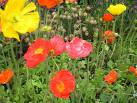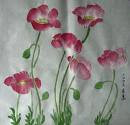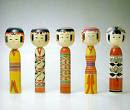::::::::::::::::::::::::::::::::::::::::::::::::::::::::::::::::::::::::::::::::::::::::::::::::::::
Poppy flowers (keshi no hana)
***** Location: Japan.
***** Season: Early Summer
***** Category: Plant
*****************************
Explanation

Opium poppy, Papaver somniferum
During the Edo period the growing of poppies was allowed for private people, mostly for medical purposes. After the opium wars in China, it became forbidden in Japan.
poppy flowers, keshi no hana 罌粟の花 (けしのはな)
..... keshi no hana 芥子の花(けしのはな)
..... hana geshi 花罌粟(はなげし)
..... azami geshi 薊罌粟(あざみけし)

field poppy, corn poppy, a coquelicot
hina geshi 雛罌粟 ひなげし
..... gubijin soo 虞美人草(ぐびじんそう)
"beautiful lady weed" bijinsoo 美人草(びじんそう)

"beautiful spring flower" reishunka 麗春花(れいしゅんか)

"devil's poppy", oni geshi 鬼罌粟 おにげし
kigo for all summer
poppy head, keshi boozu
芥子坊主, 罌粟坊主 (けしぼうず)
kigo for mid-summer

See > Welch Onion
This was also a kind of clearcut hairstyle with just one tuff, for children of three and four years old during the Edo period.

Also called suzushiro すずしろ or O-Keshi お芥子.
僧になる子のうつくしやけしの花
soo ni naru ko no utsukushiya keshi no hana
how beautiful
this boy who becomes a priest -
poppy flowers
Kobayashi Issa

:::::::::::::::::::::::::::::::::::::::::::::::::::::::::::::::::::::::::::::::::::::::::::::::::::::
A poppy is any of a number of showy flowers, typically with one per stem, belonging to the poppy family. They include a number of attractive wildflower species with showy flowers found growing singularly or in large groups; many species are also grown in gardens.
The flower color of poppy species include: white, pink, yellow, orange, red and blue; some have dark center markings. The species that have been cultivated for many years also include many other colors ranging from dark solid colors to soft pastel shades. The center of the flower has a whorl of stamens surrounded by a cup- or bowl-shaped collection of four to six petals. Prior to blooming, the petals are crumpled in bud, and as blooming finishes, the petals often lie flat before falling away.
Poppies have long been used as a symbol of both sleep and death:
sleep because of the opium extracted from them, and death because of their (commonly) blood-red color. In Greco-Roman myths, poppies were used as offerings to the dead. Poppies are used as emblems on tombstones to symbolize eternal sleep. This aspect was used, fictionally, in The Wonderful Wizard of Oz to create magical poppy fields, dangerous because they caused those who passed through them to sleep forever.
A second meaning for the depiction and use of poppies in Greco-Roman myths is the symbolism of the bright scarlet colour as signifying the promise of resurrection after death.
The poppy of wartime remembrance is the red corn poppy, Papaver rhoeas. This poppy is a common weed in Europe and is found in many locations, including Flanders Fields.
The golden poppy, Eschscholzia californica, is the state flower of California.
© More in the WIKIPEDIA !
*****************************
Worldwide use
Klatschmohn, Mohn
*****************************
Things found on the way

Takeuchi Seihō 竹内栖鳳 Takeuchi Seiho (1864 -1942)
- quote
‘Takeuchi Seiho: The Master of Modern Nihonga’
As a founder of nihonga (Japanese-style painting), Takeuchi Seiho was a pioneer in modernizing traditional Kyoto art. His works were a major influence on many of his younger peers, including Tsuchida Bakusen (1887-1936), and continue to inspire today.
This is the first large-scale exhibition of Seiho’s work since a retrospective show in 1957.
source : Japan Times, August 2013
*****************************
HAIKU
兵が足の跡ありけしの花
tsuwamono ga ashi no ato ari keshi no hana
in the footprints
of the warrior...
poppies
An anti-war poem?
Certainly, Issa feels compassion for the fragile flowers trampled by the soldier. The symbolism is heavy. This haiku has the prescript, "North Wind" (*haifuu*), which the editors of *Issa zenshuu* describe as an allusion to an old poem;
echoing Bashoo's haiku in Oku no hosomichi ("Narrow Road to the Far Provinces"):
"summer grasses...
all the remains
of warriors' dreams"
Tr. and Comment David Lanoue

Issa, 1803 age 41 living in Edo.
He had journeyed around the northern district of Edo, getting acquaintance with Akimoto, his biggest sponsor as well as best haiku friend.
At this time he was leaving from old Haiku sect that has come from Basho.
The warrior is Basho himself or Basho’s famous haiku "summer grasses.../ all the remains/ of warriors' dreams."
If so, the footprint is Basho’s evidence that shows Basho has come here. The evidence is a monument stone that is carved with the above "summer grasses .."
There were many such stones in near Edo.
Why poppy is picked up instead of “summer grasses”?
The flower is a drug so that it brings instant happiness of dreams.
© Haiga and Comment by Nakamura Sakuo
.................................................................................
more poppy haiku by Issa
生て居るばかりぞ我とけしの花
ikite iru bakari zo ware to keshi no hana
barely alive -
there is myself and this
poppy flower
Tr. Gabi Greve
just being alive
I
and the poppy
Tr. David Lanoue
Issa uses the kireji zo in the middle of line 2. This is difficult to render in a translation.
芥子の花々と見る間にあらし哉
keshi no hanabana to miru ma ni arashi kana
while looking
at all these poppies
a storm has come
Tr. Gabi Greve
This haiku is one sentence and
has the cut marker KANA at the end of line 3.
keshi no hana hana to miru ma ni arashi kana
while looking
at poppies, poppies...
a storm
David Lanoue
..........................................................................
. WKD : Kobayashi Issa 小林一茶 in Edo .
けっくして松の日まけや芥子の花
kekku shite matsu no hi make ya keshi no hana
yes, poppies,
pines live longer --
and end up sunburned
Tr. Chris Drake
This summer hokku was written at the beginning of the 4th month (May) in 1802, when Issa was in Edo. The precise basis of the comparison of poppies and pines isn't mentioned by Issa, but the first line hints that Issa is talking about time and longevity. The brilliant red (and occasionally white, blue, and purple) poppies bloom in bright sunlight-filled fields only for two months, in May and June, and Issa seems to sense that the poppy flowers want to live longer and resent their lifespan, which is much shorter than that of the pines. Pines are a traditional symbol of longevity and often used as an image for living for a thousand years, but Issa tells the poppies not to envy them, since in the long run the rays of the sun are harmful, and the pines must endure much more sunlight, which eventually "burns" their needles, changing them from green to black.
I doubt this is a political allegory, since pines were also a divine tree often used by gods when they descended, and pines were a common symbol of good fortune as well. The hokku seems to be more about urging the poppies to be proud of their brief natural beauty and to feel thankful they can go out at the moment of their most intense color instead of gradually being withered by sunlight. Isn't Issa also talking about hokku and renku here?
Chris Drake
..........................................................................
けし提てけん嘩の中を通いけり
keshi sagete kenka no naka o toori keri
holding a poppy
I walk right through
people fighting
Tr. Chris Drake
This famous hokku was written in the 4th month (May) of 1825, when Issa was living in his hometown while making constant trips to nearby towns. For Issa the intense red of poppies seems to have a special inner power that radiates outward, and in this hokku a poppy shares its power with him, allowing him to walk right through a group of people who are yelling at each other or perhaps even coming to blows. Without the poppy, Issa probably would have walked around the fight, simply avoiding it, but with the flower in his hand he somehow discovers the ability to walk calmly straight through the knot of angry people.
Red is associated in many cultures with anger and fighting or with blood and the fire of strong emotions, but for Issa it also seems to have been the color of calmness and peace. Perhaps his feeling for red is related to the fact that in Japanese the word for "red" is etymologically close to several words meaning "bright" and possibly also related to the large role red plays as a color signifying purity in Shinto. Still, peacefully carrying red into the midst of a fight seems typically Issa. Perhaps Issa's personal gentleness, together with the fact that the red color is in the shape of a flower, help him walk peacefully through the group of fighting people. Poppies are fragile and delicate, though not quite as delicate as cherry blossoms, and their petals fall easily and quickly, so the poppy he holds presents the fighters with an image of softness and flexibility, not hardness and aggression
Chris Drake

source : tomy2.blog1
みそ豆の数珠がそよぐぞ芥子の花
misomame no juzu ga soyogu zo keshi no hana
ah, poppies
your large prayer beads
swaying, rustling
Tr. Chris Drake
This early summer hokku is from the beginning of the fourth month (May) in 1813, about two months after Issa had received his half of his father's house in his hometown. The poppies are just coming into bloom, and Issa seems to be near a field of them. Poppy ovaries or fruit are called "poppy priests" (keshi-bouzu) in Japanese because they resemble the shaved heads of Buddhist monks and priests, and to Issa they now seem to resemble large prayer beads. A breeze makes the flowers sway on their long stems, and to Issa the poppy field seems to look like a great natural wave of prayer beads swaying back and forth as they praise Amida Buddha. The flowers may make a slight rustling sound when they touch, but sound doesn't seem to be the main focus here. In the True Pure Land school of Buddhism to which Issa and many of the residents of his hometown belonged, prayer beads were not considered essential for counting the number of times you said Amida's name, since sincerity was more important than number.
Believers did, however, hold strings of prayer beads of variable lengths in their hands when they put their palms together in a gassho gesture of deep respect toward Amida or Shinran, the founder of the school, even though they did not move the beads or make clicking sounds with them. The exclamatory zo in the second line indicates that Issa is addressing the poppies and telling them he's seen their new prayer beads and their wave-like prayer. No doubt his hokku is an expression of his gratitude to the poppies and to Amida for having been given the chance to witness this prayer.
Japanese prayer beads are made from a wide variety of materials, but soybeans are not a standard material. It's possible very poor farmers might have strung soybeans together to make prayer beads, but some kinds of wooden prayer beans were inexpensive and easily obtained. They would also have been more durable than beans. It seems likely that Issa is using large soybeans in this hokku to refer to the size of the poppies' fruit and to indicate to readers that he's not referring to ordinary human prayer beads. Calling something "bean-sized" (mame-dai) is common in Japanese, and when I called five prayer-bead stores and asked if they used beans as metaphors, people in three of the stores told me they sometimes describe large prayer beads as being "bean-sized."
Issa also connects poppies with Buddhism in this famous 1823 hokku:
how beautiful this boy
who's becoming a monk --
a flowering poppy!
Chris Drake

source : www.trekearth.com/gallery
:::::::::::::::::::::::::::::::::::::::::::::::::::::::::::::::::::::::::::::::::::::::::::::::::::::
kaite mitari keshitari hate wa keshi no hana
I write, erase, rewrite,
erase again, and then
a poppy blooms
Tr. Hoffman
WKD: Tachibana Hokushi (1665-1718)
An exerpt from Hoffman's comment:
'Keshi' means "to erase" as well as "poppy..." However it is read, the poems intent remains the same--that nature eventually overwhelms culture. [end of comment]
About 'keshi', David Barnhill says in his notes to Basho's haiku
(Major Nature Images in Basho's Hokku):
A petal that falls off a poppy is said to resemble a severed butterfly wing, and thus is associated with painful parting. [end of comment]
And in Gill's "Cherry Blossom Epiphany," in commenting on a particular haiku, Gill says that a child who lived in a monastery was "called a 'keshi-no-tsuke', after the poppy flower that dropped its petals so quickly it was synonymous with a tenuous existence."
Erasure, parting, tenuous existence... it does suggest a similar feeling as Basho's "summer grasses" haiku.
Then there is the use of the word 'keshi' in the title of an episode of a Japanese tv series, "Sukeban Deka" (Juvenile Cop):
Keshi no tatakai! (translated as "Battle to the Death!)
Can 'keshi' mean death in an idiomatic way?
Larry Bole
Almost everyone familiar with Japanese wooden dolls knows about kokeshi.
Many people believe that early kokeshi were representations of girl children that were aborted or put to death after childbirth due to the inability to support a poor family of greater size. Even the word, ko-keshi (ko o kesu), can be loosely translated as "extinguished child" or "a child wiped out".
It may be that kokeshi were kept as reminders of a dead child's plaything. Kokeshi are also given as charms to childless women in an effort to get pregnant. Kokeshi were kept in the family and passed down from generation to generation. Some believe that kokeshi date back three hundred years and were the North's equivalent of the standing hina dolls.

Read more about
... Daruma and Kokeshi Dolls
Gabi Greve
*****************************
Related words
. karashi tane maku 芥菜蒔く (からしなまく)
sowing mustard seeds
(The kanji 芥 can also meen mustard seed.)
kigo for mid-autumn
:::::::::::::::::::::::::::::::::::::::::::::::::::::::::::::::::::::::::::::::::::::::::::::::::::::
kigo for mid-summer
hanabishisoo 花菱草 (はなびしそう) California poppy
..... kineika 金英花(きんえいか)
PoppyEschscholzia californica . Eschscholtzia
:::::::::::::::::::::::::::::::::::::::::::::::::::::::::::::::::::::::::::::::::::::::::::::::::::::
***** Japanese Warriors and Haiku (tsuwamono)
***** Poppy Day, Rememberance Day, Veteran's Day
***** War and Peace in Haiku
. Akakeshi 赤芥子 Red Poppies Dolls .
from Miyagi
[ . BACK to WORLDKIGO . TOP . ]
:::::::::::::::::::::::::::::::::::::::::::::::::::::::::::::::::::::::::::::::::::::::::::::::::::::






10 comments:
"lovely stuff, Gabi... as aways!"
BB
wonderful post.
D
The haiku world is fantastic!
JL
barely alive -
there is myself and this
poppy flower
Tr. Gabi Greve
Dear Gabi, your translation seems much better.
Regards, Sunil
Your translation seems indeed much better, and is quite inspiring ...
summer wind
this poppiy blossom and I
both swaying
Ella
http://groups.yahoo.com/group/kigohotline/message/1980
Matsuo Basho wrote
In 1685, Basho age 42, Tokoku age 30 :
白芥子に羽もぐ蝶の形見哉
白げしにはねもぐ蝶の形見哉
shirageshi ni hane mogu choo no katami kana
for this white poppy
the butterfly tears off its wings
as a keepsake . . .
Tr. Gabi Greve
Here Basho sees Tokoku as a white poppy and himself as a parting butterfly. This is a strong expression of his feelings toward Tokoku.
This combination of flower and animal is quite unusual.
This hokku has the cut marker KANA at the end of line 3.
Matsuo Basho
白芥子や時雨の花の咲きつらん
shira-geshi ya / shigure no hana no / saki tsuran
Matao Basho
海士の顔まづ見らるるや芥子の花
海士の顔先見らるゝやけしの花
ama no kao mazu miraruru ya keshi no hana
MORE
about woman divers and fishermen
Kobayashi Issa
ikite iru bakari zo ware to keshi no hana
hey, we're
staying alive, me and
the poppies
Read the comment by Chris Drake:
keshitoo 芥子糖(けしとう)candy with poppy seeds
in the Edo period
sweets of Edo
Post a Comment